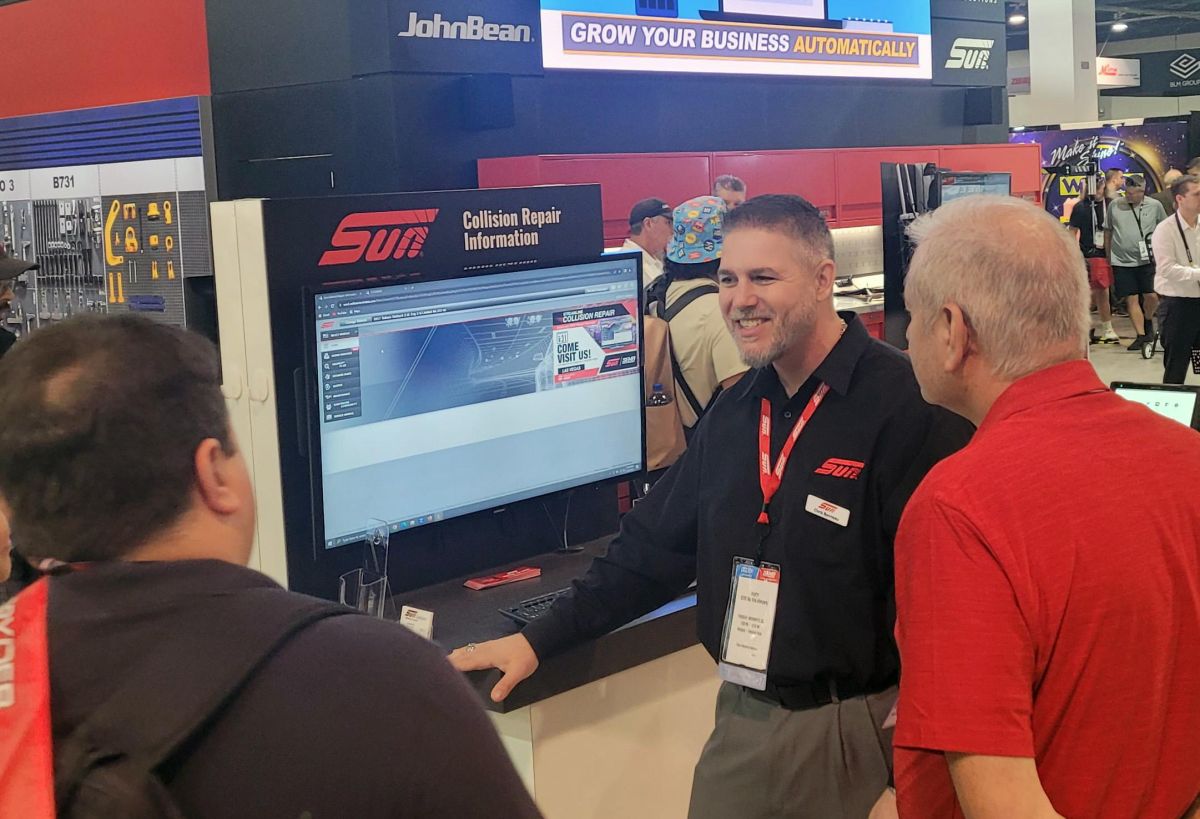Technology’s a little like magic -- but only a little.
In the old expression of the Six Million Dollar Man, it’s being “better, stronger, faster.”
Don’t believe the chatter. Do the work; believe the results. To be better and stronger you first have to be good (even best) and capable (even buff) to begin with. Tech -- software and such -- focuses on the faster. If your painting is lousy and your customer service is worse, faster won’t help. You just burn dinner quicker.
But, if you’re humming, now we’re talking.
Collecting and Organizing, Really Fast
To be honest, with all the AI and ADAS hype, software feels a bit “old school.”
But honesty’s good, and hustling techs still stay humble: they’re always in school, and they’re hustling.
“That’s where software comes into play,” said Chris Bonneau. “You save time -- especially research time -- because it gets you into the procedures as fast as possible, [and you can] move on to the next project.”
Bonneau is a business manager with San Diego-based SUN Collision, a software-as-a-service (SaaS) provider pledging “comprehensive, accurate collision and mechanical data in a single look-up,” according to its website. It’s part of Snap-on’s Total Shop Solutions package with several sister brands.
“Our goal is to get you the right information as fast as possible,” Bonneau recently told Autobody News. “Do it correctly and efficiently. Nobody’s making money sitting inside my product.”
Specifically, software gets what a shop otherwise needs to get on its own: parts numbers, repair procedures, the whole schmear, in a printable PDF planning package -- “all items in one document,” Bonneau said. “We serve a buffet, you pick what you want; you’re not hunting for your groceries.”
A hyperlinked table of contents for any web device, or as the website tagline-cum-mantra succinctly puts it: “Maximize your shop’s performance and profits.”
Teaching to the Test
Correctly. Efficiently. Maximize.
These presume initial action on your part. It’s like taking tests, back in those “old school” days: we had to come rested and ready, studious and steadfast.
 Chris Smart.
Chris Smart.
Collision centers still “write the estimate, understand the procedures,” said Chris Smart, vice president of the Collision eCommerce business at Cleveland-based SaaS maker OEC.
Meaning if we’re not sharp, it doesn’t matter how sharp our No. 2 pencil is. But if we prepare, we need a pencil. Not to mention the test, stapled neatly and waiting.
Tests -- the vehicle in front of you -- maybe aren’t so neat and patient anymore, but we still need that pencil.
Today, it’s faster. The software is the pencil. OEC’s aim, according to its website: “Access to the network and data needed to transform selling, sourcing, leasing, managing, billing and claims.”
Smart said it’s “ensuring we cut down on cycle time” with parts, for instance. “Ordering accurately the first time,” along with third-party logistics and communications, integration and delivery.
This means, he said, shops can focus on the repair.
“At the end of the day, it’s ordering the right part, accurately, at a reasonable price,” he said. “All part types on one platform, OE on another.”
Scaling Up, Even As an Independent Body Shop
This is only for MSOs, right?
No. This is for any collision center that wants to plan repairs more efficiently.
 Taylor Moss.
Taylor Moss.
“Embracing technology is critical for independent shops because they don’t have the economies of scale,” said Taylor Moss, cofounder of RepairLogic, OEC’s cloud-based repair planning offering. “Embrace technology to save time, and maximize what they can get from each repair.”
“Independents that do everything need systems that help them,” said Bonneau. “People are trying to find ways to increase their bottom line, and most of the time that means turning more vehicles.”
If more space, equipment or people aren’t an option, he said, “it’s processes.”
Software is “absolutely for the solo operator,” said Smart. Consolidation’s a constant, MSOs will grow, “but there are tens of thousands of independent repair shops looking to become more efficient, get better pricing.”
Platform presentation, procurement, pricing, he said. In other words, all shops centralize processes. MSOs standardize stuff at higher levels -- that’s why they call it “corporate” -- but a shop is a shop is a shop.
“MSOs centralize their processes” with software, Smart said. “An independent also wants to drive automation because they don’t have the time or the manpower.”
Software Runs in the Background
The other option at this point is an actual pencil. Those old BASF commercials talked innovation -- “We don’t make a lot of the products you buy. We make a lot of the products you buy better” -- but the message was hiding and that was the point. You might not see it, but it makes stuff better and stronger, and you’d miss it if it were gone.
Customers will never see SUN or OEC, but we never see any software. It runs in the background, becoming the new normal, as we come to rely on it.
When the Yankees caught some press -- and some flak -- for swinging (entirely legal) torpedo-shaped bats at the beginning of the new baseball season, it didn’t keep other teams from trying it out. In truth, they already had: the Cubs, last year, and the Rays, Twins and Blue Jays this year had players testing the new technology.
“Software” is like that. We come to think of it becoming better and stronger, but really it’s making us better and stronger.
Collecting and organization information really, really, really fast means we look and get that way. Better and stronger come with faster.
“Software is one source for digital repair planning,” Moss said.
It becomes essential. Or it gets bypassed, as shops learn.
“If they can’t find it easily, they don’t do it,” Bonneau said.
Techs become GC – “Google certified” -- which isn’t quite the same thing as OE.
OE Focus Grows Locally as Technology Does Globally
As technology overall continues more than apace beyond the body shop and collision center universe, so too within it does the need to automate.
“One thing, the most important for everyone, is making sure you have proper procedures, identifying what those procedures are, in a consistent and easily searched manner,” Bonneau said.
Everything in the software orbits OE procedure, he said. It’s also available through the Database Enhancement Gateway (DEG) or the carmaker sites, but then you wade through different wording from different manufacturers, just for starters, and it -- the terminology and the procedure -- doesn’t stay the same.
“Vehicles and procedures change constantly,” Bonneau said. “The procedure could’ve changed from yesterday to today, or a month ago, same exact year, make and model.”
“One vehicle might have 20,000-plus repair procedures,” Moss said, noting RepairLogic’s strong OE-focus.
Companies also say documentation can strengthen shops’ daily jousting with insurance carriers.
“You’re never going to solve the pushback” with insurers, Moss said, but pulling procedures “shows the right repair the manufacturer authorizes. It formulates the choice and proves why shops need to do it.”
Software, then, seeks to serve up “the most accurate, current, easiest-to-find data,” Bonneau said. It’s a set of “solutions out there that do similar things.”
Future of Technology for Training and Technicians
To buttress the point, Bonneau mentioned software: “It’s like Android and iPhone: they both do similar things in a different way.”
In that sense, it’s for everyone -- bodies and body shops, whether present or future. SUN has kicked in on success at this California shop, for instance. OEC has its software in nine K-12 schools and community colleges, in Oregon and in Nebraska, among others.
A phrase we know from software in general is “user-friendly,” which means, again, anyone.
Moss said, “Data shows it’s good for upskilling new employees.”
Bonneau said, “I could give it to you right now, turn it over to a novice.”
Just type it in -- “even with spelling errors,” he said, “like Google.”
As for pencils and tests, Moss said OEC’s EstimateIQ includes a “two-minute audit tool” which is essentially “spell check,” but for not-included operations, forgotten items and “consistency from estimate to estimate.”
Curiously -- and helpfully -- enough, all this happens faster. Companies spend thousands of hours to ensure software improves at the speed of business, incorporating technician input and technology advances.
“The landscape now is the complexity of the vehicles is changing,” Bonneau emphasized. “You have to worry about carbon, high-strength steel, aluminum … If the vehicles have software,” how can a shop not do so.
“At all the conferences, the top shops, Mike Anderson, all those guys say the same thing. Every time you see a vehicle, treat it as the first time.”













Paul Hughes